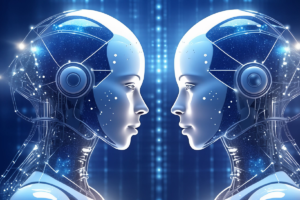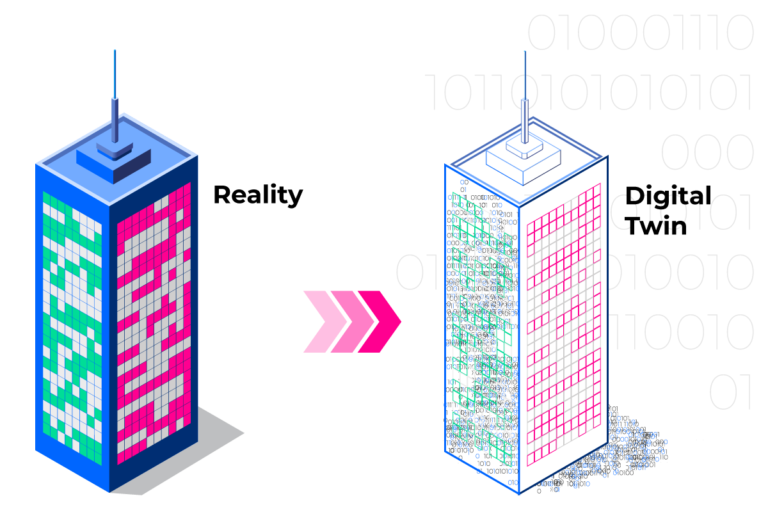 In our increasingly digital world, the concept of “Digital Twins” has become more and more important. Originally known in an industrial context, the concept has expanded to not only involve products or machines, but also organizations as a whole. We are talking here about Digital Twins of Organizations (DTO). Learn about the advantages of a DTO, what it can be used for, and why the topic is particularly relevant in the context of AI.
In our increasingly digital world, the concept of “Digital Twins” has become more and more important. Originally known in an industrial context, the concept has expanded to not only involve products or machines, but also organizations as a whole. We are talking here about Digital Twins of Organizations (DTO). Learn about the advantages of a DTO, what it can be used for, and why the topic is particularly relevant in the context of AI.
What is a Digital Twin?
The term Digital Twin was introduced at the beginning of the 21st century in the context of the Internet of Things (IoT). The origin of the Digital Twin lies in the production and manufacturing industry. The classic Digital Twin is defined as:
Digital Twin
A Digital Twin is a virtual image of a physical object or system.
The physical object captures data using sensors and converts it into a digital model. The digital copy can be used to monitor and control the entire life cycle of the physical object continuously and in real time.
Digital Twins can now be found in many areas. In addition to the manufacturing industry and production development, they are also used in agriculture, healthcare and urban planning.
The concept of the original Digital Twin has expanded in the context of big data and more comprehensive data analysis techniques. In addition to the virtual copy of individual systems or objects, these can not only just be digitally mapped in isolation, but also together and in context with each other. We are then talking about the Digital Twin of an Organization (DTO).
Digital Twin of an Organization
A Digital Twin of an Organization (DTO) is a digital model that includes all processes in a company and links them together. This virtual copy of the organization is created using data drawn from operational systems such as ERP and CRM or other data sources. The DTO aims to monitor and optimize processes and make decisions more easily, thanks to absolute transparency.

How to create a Digital Twin?
A Digital Twin is a data construct. In order to create a Digital Twin, you need to obtain the information that represents it. In the case of the classic Digital Twin, which is made up of the machine data of a system, for example, this transfer takes place via sensors. The sensors feed all the data they collect into the digital model in real time.
In case of the Digital Twin of an Organization, the core data is more comprehensive. The data model is not made up of just one source, but receives data from a wide variety of systems. Suitable technologies are needed to receive this data, to put it into context, and to analyze it. The methodology of Object-Centric Process Mining is considered very promising here. The market research company Gartner predicts the development of Digital Twins and Process Mining as the following:
“By 2026, 25% of global enterprises will have embraced process mining platforms as a first step to creating a digital twin for business operations, paving the way to autonomous business operations.”
Gartner, Magic Quadrant for Process Mining Platforms, April 29, 2024
What are the advantages of a Digital Twin?
Digital Twins have many advantages thanks to their functionalities for monitoring, controlling, and forecasting events and processes. In the business world, the field of Digital Twins is still relatively new. Not all companies have a sufficient level of digital maturity to turn the theory of virtual twins into reality. Organizations and companies that get to grips with DTOs at an early stage can create a technological competitive advantage for themselves. Companies with a Digital Twin can benefit from these advantages:
- Increasing efficiency:
Identifying and eliminating inefficiencies, increasing productivity & reducing costs - Driving innovation:
Analyzing data to uncover new growth opportunities and business potential - Optimize use of resources:
Companies can test different scenarios to determine the best use of resources, whether in terms of personnel, materials or financial resources - Secure decision-making:
Make informed decisions based on comprehensive insights into processes and simulated future scenarios - Risk management:
Risks and their impact on business processes can be simulated to plan preventative measures - Reaction to market changes:
Simulations allow companies to react quickly to changes in the market and adapt their processes accordingly
Use Cases of a Digital Twin of an Organization
Regardless of the company or industry in question, several use cases have emerged in connection with a DTO. The DTO is suitable for the continuous optimization of processes, for simulating various future scenarios and for creating a sound database for the successful use of artificial intelligence.
Process optimization
Once you have a virtual image of your business processes, you can more easily analyze them and gain valuable insights. In this way, weaknesses such as bottlenecks or new opportunities can be identified. The targeted improvement of various parameters within the processes can increase the overall efficiency of the company and save costs.
Process simulation
In addition to monitoring processes in real time and analyzing historical process data, a DTO can also be used to look into the future. Using intelligent algorithms, the Digital Twin can simulate various future scenarios. The digital simulation enables companies to test and visualize different scenarios to see how various parameters and changes affect efficiency, resource utilization, or other key performance indicators before they are implemented in reality. Business Process Simulation is therefore the perfect basis for reliable decision-making.
Use of AI
Artificial intelligence (AI) plays a crucial role in the context of the Digital Twins of companies. As already described, a DTO is fed from all possible data sources in a company. This comprehensive database, from which the Digital Twin is made, provides a solid foundation for the effective use of artificial intelligence.
The use of AI helps in the mentioned use cases, such as process optimization and process simulation. Here AI helps to improve data analysis by identifying complex patterns and correlations that would be difficult for human analysts to recognize. It can also make more accurate predictions about future trends and developments.
Finally, the broad database of a DTO has another advantage. It solves a problem that often arises with AI - the criticism that the data sources are not always clear and trustworthy. For a company that wants to work with valid data, the DTO's database is made of clean, unbiased, accurate data.
How Process Mining helps to create the Digital Twin of an Organization
Digital Twins of Organizations (DTOs) are changing the way companies optimize processes and make strategic decisions. Our host Boris Michel discusses with Constantin Wehmschulte, CPO of mpmX, the concept of DTOs, practical use cases, and how Digital Twins can be created based on data with the help of Process Mining. In addition, the question of why the Digital Twin is the prerequisite for a meaningful and well-founded use of AI in companies will also be answered.
LinkedIn Live | mpmX in Focus: Digital Twin of an Organization
Find out more about how Process Mining can make your path to the DTO easier.
[1] https://www.iks.fraunhofer.de/de/themen/digital-twins.html#:~:text=Digital%20Twins%3A%20Eine%20Einf%C3%BChrung%20in,und%20medizinischen%20Patientinnen%20und%20Patienten.
[2] https://www.ibm.com/de-de/topics/what-is-a-digital-twin
[3] https://news.microsoft.com/de-de/microsoft-erklaert-was-sind-digital-twins/
[4] https://research.aimultiple.com/digital-twin-of-an-organization/
[5] https://aisel.aisnet.org/cais/vol52/iss1/26/#:~:text=Digital%20twins%20of%20organizations%20are,improve%20organizational%20activities%20over%20time.
[6] https://www.gartner.com/en/documents/5391263

